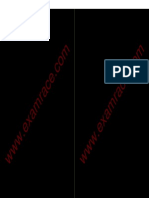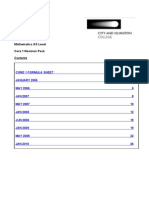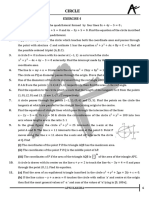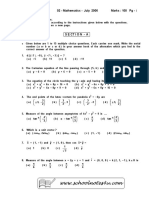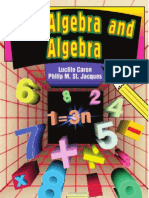0 ratings0% found this document useful (0 votes)
111 viewsVector Calculus and Co-Ordinate Geometry: X Z y Z
1) State and prove the Divergence theorem and use it to evaluate a line integral over a cube.
2) Determine the conditions under which a vector field is irrotational or solenoidal.
3) Use vector operations like divergence and curl to analyze scalar and vector fields.
Uploaded by
Aswini SamantarayCopyright
© © All Rights Reserved
Available Formats
Download as DOCX, PDF, TXT or read online on Scribd
0 ratings0% found this document useful (0 votes)
111 viewsVector Calculus and Co-Ordinate Geometry: X Z y Z
1) State and prove the Divergence theorem and use it to evaluate a line integral over a cube.
2) Determine the conditions under which a vector field is irrotational or solenoidal.
3) Use vector operations like divergence and curl to analyze scalar and vector fields.
Uploaded by
Aswini SamantarayCopyright
© © All Rights Reserved
Available Formats
Download as DOCX, PDF, TXT or read online on Scribd
You are on page 1/ 1
Vector calculus and co-ordinate geometry
1. State and prove Divergence theorem.
2. Given A=ax+ay, B=ax+2az and C =2ay+az. Find (AXB)XC and compare it with AX(BXC).
Using the above vectors, find A.BXC and compare it with AXB.C.
3. Find the value of the constant a, b, c so that the vector E=(x+2y+az)ax+(bx3y
2z)ay+(4x+cy+2z)az is irrotational.
4. Using the Divergence theory, evaluate E.ds = 4xz ax y2 ay+yz az over the cube bounded by
x = 0; x = 1; y = 0; y = 1; z = 0; z = 1.
5. State and derive the Stokes theorem.
6. Determine the constant c such that the vector F = (x + ay)ax+ (y + bz)ay + (x + cz)az will be
solenoidal.
7. If P1, is (1, 2, - 3 ) and P2 is ( - 4 , 0, 5), find
(a) The distance P1P2
(b) The vector equation of the line P1P2
(c) The shortest distance between the line P\P2 and point P3(7, -1,2).
8. Show that vectors a = (4, 0, - 1 ), b = (1,3, 4), and c = (-5, - 3 , - 3 ) form the sides of a
triangle. Is this a right angle triangle? Calculate the area of the triangle.
9. Convert points P(1, 3, 5), T(0, - 4 , 3), and S(-3, - 4 , -10) from Cartesian to cylindrical and
spherical coordinates.
10. Given P= xy + yz + xz, find gradient P at point (1, 2, 3) and the directional derivative of P at
the same point in the direction toward point (3, 4, 4).
11. Determine the divergence of the vector field A = yz ax + 4xy ay + y az at (1, -2, 3).
12. For a scalar field V, show that XV = 0; that is, the curl of the gradient of any scalar field
vanishes.
13. Show that B = (y + z cos xz)ax + xay + x cos xz az is conservative, without computing any
integrals.
14. Determine the unit vector normal to S(x, y, z) = x2 + y2 z at point (1, 3, 0).
15. If U = xz x2y + y2z2 , evaluate div grad U.
16. Verify the divergence theorem for A = xy2ax + y3ay + y2zaz and S is the surface of the cuboid
defined by 0 < x <1, 0 <y < 1,0 < z < 1
17. Given the vector field G = (16xy z) ax+8x2 ay x az
(a) Is G irrotational (or conservative)?
(b) Find the net flux of G over the cube 0 < x, y, z < 1.
(c) Determine the circulation of G around the edge of the square z = 0, 0 < x, y < 1.
Assume anticlockwise direction.
18. Given that A = xy ax + yz ay+ xz az, evaluate s A dS, where S is the surface of the cube
defined b y 0 < x < l , 0 < y < l , 0 < z < 1.
You might also like
- The Art of Problem Solving Intermediate Algebra96% (25)The Art of Problem Solving Intermediate Algebra720 pages
- Beginner's Step-By-Step Coding Course Learn Computer Programming The Easy Way, UK Edition98% (46)Beginner's Step-By-Step Coding Course Learn Computer Programming The Easy Way, UK Edition360 pages
- The Motivational Interviewing Workbook - Exercises To Decide What You Want and How To Get There100% (10)The Motivational Interviewing Workbook - Exercises To Decide What You Want and How To Get There224 pages
- Golf Strategies - Dave Pelz's Short Game Bible PDF92% (24)Golf Strategies - Dave Pelz's Short Game Bible PDF444 pages
- Catherine V Holmes - How To Draw Cool Stuff, A Drawing Guide For Teachers and Students97% (35)Catherine V Holmes - How To Draw Cool Stuff, A Drawing Guide For Teachers and Students260 pages
- [Algebra Essentials Practice Workbook with Answers Linear and Quadratic Equations Cross Multiplying and Systems of Equations Improve your Math Fluency Series] Chris McMullen - Algebra Essentials Practice Workbook with A.pdf80% (10)[Algebra Essentials Practice Workbook with Answers Linear and Quadratic Equations Cross Multiplying and Systems of Equations Improve your Math Fluency Series] Chris McMullen - Algebra Essentials Practice Workbook with A.pdf207 pages
- Math 87 Mathematics 8 - 7 Textbook An Incremental Development Stephen Hake John Saxon100% (10)Math 87 Mathematics 8 - 7 Textbook An Incremental Development Stephen Hake John Saxon696 pages
- Self-System Therapy For Depression Client Workbook100% (8)Self-System Therapy For Depression Client Workbook113 pages
- Chris McMullen - Intermediate Algebra Skills Practice Workbook With Answers - Functions, Radicals, Polynomials, Conics, Systems, Inequalities, and (2021, Zishka Publishing) - Libgen - Li100% (3)Chris McMullen - Intermediate Algebra Skills Practice Workbook With Answers - Functions, Radicals, Polynomials, Conics, Systems, Inequalities, and (2021, Zishka Publishing) - Libgen - Li502 pages
- 2 3 (X, X) 2 3 (X, (X+ X) : Candidates Should Attempt Any FIVE Questions. All Questions Carry Equal MarksNo ratings yet2 3 (X, X) 2 3 (X, (X+ X) : Candidates Should Attempt Any FIVE Questions. All Questions Carry Equal Marks10 pages
- 2 3 (X, X) 2 3 (X, (X+ X) : Candidates Should Attempt Any FIVE Questions. All Questions Carry Equal MarksNo ratings yet2 3 (X, X) 2 3 (X, (X+ X) : Candidates Should Attempt Any FIVE Questions. All Questions Carry Equal Marks10 pages
- Advanced Technology M7 "Fields and Waves" Vector Field TheoryNo ratings yetAdvanced Technology M7 "Fields and Waves" Vector Field Theory3 pages
- Chapter Practice Problems: Straight LinesNo ratings yetChapter Practice Problems: Straight Lines5 pages
- IAS Mains Mathematics 1992 IAS Mains Mathematics 2014 2IN1No ratings yetIAS Mains Mathematics 1992 IAS Mains Mathematics 2014 2IN1164 pages
- Vector Calculus - Solutions 1: 1. in Each Case, S Is The Shaded Region, Excluding Any Hatched Lines/curves. (A) (B)No ratings yetVector Calculus - Solutions 1: 1. in Each Case, S Is The Shaded Region, Excluding Any Hatched Lines/curves. (A) (B)7 pages
- CERTC RGS Advanced Math 2 Vector CalculusNo ratings yetCERTC RGS Advanced Math 2 Vector Calculus2 pages
- Linear Equations in two variables_Test Papers(Class-9No ratings yetLinear Equations in two variables_Test Papers(Class-97 pages
- Math 265 Name & Section: Final Exam S2009 InstructorNo ratings yetMath 265 Name & Section: Final Exam S2009 Instructor4 pages
- Coordinate Geometry in The (X, Y) - Plane: 3.1. LinesNo ratings yetCoordinate Geometry in The (X, Y) - Plane: 3.1. Lines4 pages
- 21188208-fe31-4040-8c18-c4d961292ef8-1738523413589-4102600920398609No ratings yet21188208-fe31-4040-8c18-c4d961292ef8-1738523413589-410260092039860937 pages
- National Institute of Technology Goa Dept of Electrical and Electronics EngineeringNo ratings yetNational Institute of Technology Goa Dept of Electrical and Electronics Engineering2 pages
- Message: Mr. Saswat Kumar Ram DSW, CvrgiNo ratings yetMessage: Mr. Saswat Kumar Ram DSW, Cvrgi1 page
- Objective Questions Moderate Identify Which of The Following Quantities Is Not A VectorNo ratings yetObjective Questions Moderate Identify Which of The Following Quantities Is Not A Vector7 pages
- Objective Questions Moderate Identify Which of The Following Quantities Is Not A VectorNo ratings yetObjective Questions Moderate Identify Which of The Following Quantities Is Not A Vector7 pages
- Message: Mr. Aswini Kumar Samantaray Dean, Student's Welfare, CVRGINo ratings yetMessage: Mr. Aswini Kumar Samantaray Dean, Student's Welfare, CVRGI1 page
- Message: Mr. Saswat Kumar Ram DSW, CvrgiNo ratings yetMessage: Mr. Saswat Kumar Ram DSW, Cvrgi1 page
- C V Raman College of Engineering Blood Donation Camp-2017 Duties and ResponsibilitiesNo ratings yetC V Raman College of Engineering Blood Donation Camp-2017 Duties and Responsibilities2 pages
- A New Fast and Efficient Decision-Based Algorithm For Removal of High-Density Impulse NoisesNo ratings yetA New Fast and Efficient Decision-Based Algorithm For Removal of High-Density Impulse Noises4 pages
- Kalyankumar333@gmail. Com Prabodh - Eng@yahoo - Co.i N Devpriya - Panda@gmail.c OmNo ratings yetKalyankumar333@gmail. Com Prabodh - Eng@yahoo - Co.i N Devpriya - Panda@gmail.c Om1 page
- Here Are A Few Simple and Practical Tips To Keep Dengue at BayNo ratings yetHere Are A Few Simple and Practical Tips To Keep Dengue at Bay1 page
- Florida Teacher Certificate Examinations (FTCE) Study Guide0% (2)Florida Teacher Certificate Examinations (FTCE) Study Guide20 pages




































